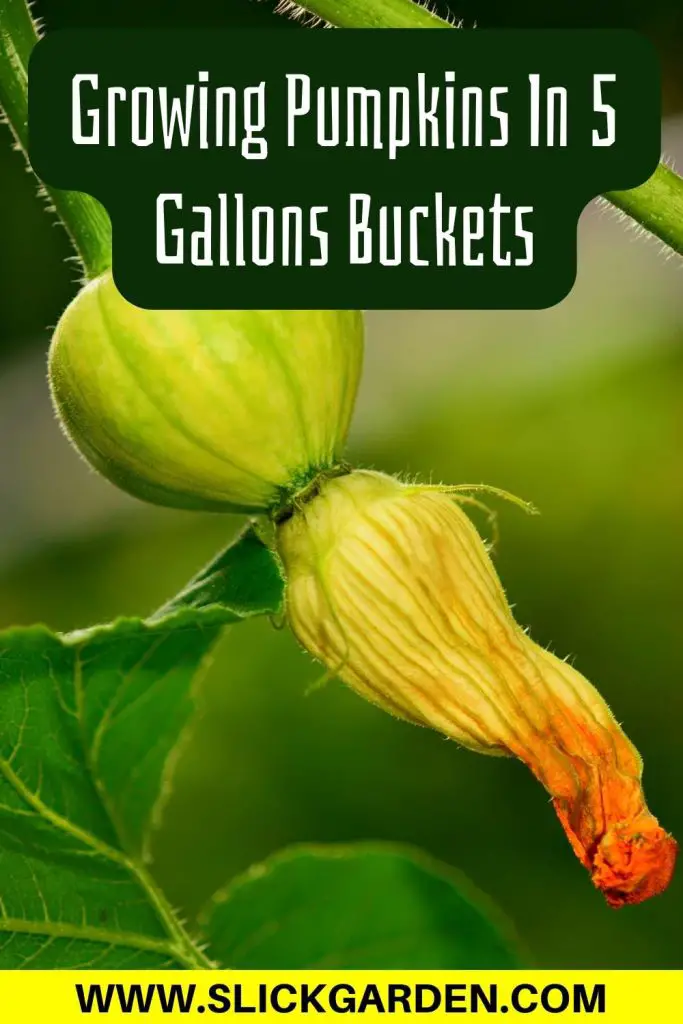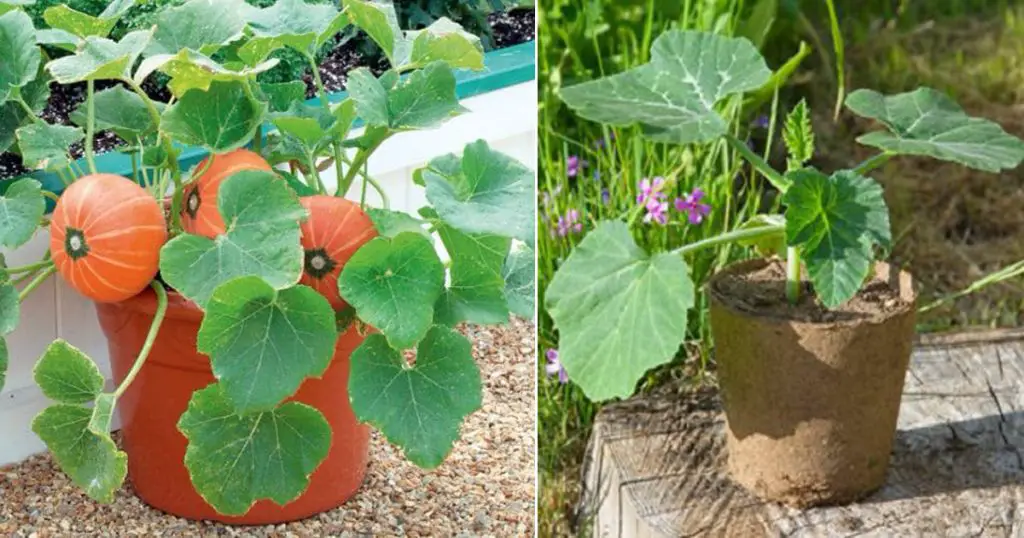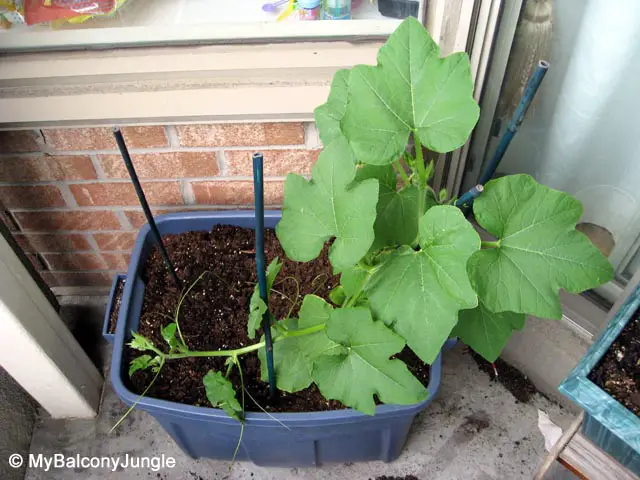It is not impossible to grow pumpkins in a 5-gallon bucket, it might be difficult to start but not impossible. You can even get bigger pumpkins and a bigger harvest if you follow these steps.
Because pumpkins are heavy feeder plants, you should consider bigger pots, and a 5-gallon bucket can do the trick for you. Plus larger pots can hold more water than smaller ones and that is why you will require to give less frequent water to plants in larger pots.
Selection Of Container
It is very easy to grow pumpkins in 5 gallon-pots. Pumpkin plants are great climbers, so they enjoy great heights and trellises even when growing indoors with a sunny window.
One of the most important parts of growing pumpkins in buckets is to choose the right size for your bucket. If you do not get the right size, your plant will not do very great in terms of production.
The larger bucket will provide a lot of space to spread the roots, which allows the plant to grow and produce more and bigger pumpkins. Buckets of 5 to 15 gallons (20-60 liters) are great to grow pumpkins, although the bigger the better for better growth.
If you want to make your bucket more decorative and beautiful, you can paint the buckets with your favorite colors to match the color of your roof or balcony.
Cultivars To Grow
You can grow any kind of pumpkins in buckets if the size is good enough but you should always choose varieties that produce smaller fruits. These varieties will do great in 5-gallon buckets.
Bushkin
This variety is a compact, shrub-type pumpkin, suitable for containers or small gardens. The vine of this variety will grow only 5-6 feet.
Baby Bear
This variety can take up to 105 days to give you your first ripen pumpkin. The size of the baby bear will be half of the normal bigger pumpkin, but you can still produce fruit of 2 lb’s. Baby beer pumpkins are perfect for baking pie!
Baby Boo
Baby boo is a creamy, white, small pumpkin that is usually 2-3 inches in diameter (cute pumpkin for kids). The flesh of these baby pumpkins is edible, and when it is fully ripe, the color becomes light yellow.
Essentials To Grow Pumpkins In 5-Gallon Buckets
These three things are necessary to grow pumpkins in 5-gallon buckets that are:
Seeds:
You can simply buy the seeds of your favorite variety from the supermarket or you can get the seeds from pumpkins.
5-Gallon Bucket
Buckets of 5 gallons or any container that is bigger than 12 inches can be used to grow these varieties.
Soil
Pumpkins are heavy feeders, so be sure to make a perfect soil mix for them. You can buy potting soil from a nursery or you can make your own soil with compost or manure, garden soil, and coco peat or peat moss.
Planting Process
This process can b divided into the following steps like
Preparation Of Bucket
Drill some drainage holes in your bucket. This will allows the soil to breathe and leave room for drainage of extra water if overwater. Drill 4-5 holes at the bottom using a hot iron bar or simply using a drill machine. Do not make too many holes.
Place seeds in the holes
Plant seeds in the soil just 1 inch deep. Cover it with the same soil, Sow 3 or 4 seeds per pot, then thin the seedlings into one or two, depending on the size, when the second real set of leaves is ready.
Seeds usually take 5-10 days to germinate. Pick the best-growing seedlings and thin them. In my opinion, just one plant will do great in a 5-gallon bucket. Next, place your bucket in a place where it will receive 6-8 hours of sunlight.
Water Regularly
Regularly watering is necessary for the seeds and growing seedlings, not just when they start to wilt. Keep the seeds moist until the leaves sprout. A little moisture in the soil helps the roots of seedlings to grow deeper into the soil, so they are less likely to die.
Make A Support System For Plants
Considering the overall size of the vines, you will need to build strong and large trails that can support pumpkin vines. We should not allow the vines to grow bigger along with the ground, it can cause serious problems like fungal attacks.
You should use A-shaped trails to support pumpkin plants. As your plant grows, you will need to train the vines along with the support system.
Just tie your vine with the trellis a few times and the vine will take over from there.
Select Spot To Place Container
If you have a fence and that fence receives 6-8 hours of direct sunlight, you are in great luck. Put your bucket at that point and then plant your seeds. Pumpkin plants need 6-8 hours of sunlight to thrive, so always put your bucket in that spot for better production of pumpkins.
Best Season To Grow Pumpkins
Pumpkins are not frost-friendly, so you need to plant them in containers when the temperature is above 65 degrees Fahrenheit. It depends on where you are living, but generally, they can be planted in most USDA zones in late April and May.
If you live in a warm climate where the frost is not an issue, you can plant pumpkins in July for the next crop in October or around November. People who live in subtropical or tropical climates can grow pumpkins all year round.
Care For Container Grown Pumpkins
Your pumpkin plants are growing happily in your buckets, but now you need to keep them happy. Here is how can take care of your pumpkin plants growing in containers.
Water frequently:
Watering is one of the many things that depend on the area where you are living, weather conditions, and soil type. Generally, pumpkin plants need frequent watering in buckets or containers. But you can simply check the moisture level of the soil by sticking your finger in the soil. The top 2-3 inches of soil must keep moisture for better growth.
Mulching
Mulching is necessary to protect your vines from drought conditions, putting some organic matter in the soil and keeping the weeds under the soil. All these benefits can be used by using mulch. Wait a few days before mulching so your plants can grow up to 6-12 inches because you don’t want to cover your seedlings accidentally.
Feeding
As mentioned earlier, pumpkin vines are heavy feeders, and if you want a good crop, you will need organic fertilizers, you can use compost and manure as fertilizers.
For starters, you should always use good quality potting mix in buckets to grow. There is no need of fertilizers if your soil mix is the best kind, but use compost or fully decomposed manure every 4-5 weeks.
Hand Pollination
Pollination is the most important step if you want to get fruit from your plants. Bees and other pollen can do the work for you most of the time, but if you find that the flowers are not being pollinated, you may need to do it by hand.
The ovary, or fruit of pumpkin, begins at the base of the female flowers and appears a few days after the male flowers. Male flowers have pollens to fertilize female flowers.
Here is how you can pollinate the flowers with your hands, take a cotton swab, and gently wrap it around the male flower, collecting the pollen, now transfer the pollen and rub the broom inside the female flower. Here you are just playing the role of bees and birds.
Keep Reading
- 20 Best Vegetables To Grow In Buckets
- Vegetables In One Gallon Container
- Vegetables You Can Grow In 3-Gallon Pots
Dealing with pests
Pumpkin plants can fall victim to a variety of pests and diseases just like other fruit-bearing plants.
Aphids
Aphids are small, soft-bodied insects that can attack the sticks of leaves. The leaves of the vine will turn yellow if the attack is too severe.
A mold growth can be seen on the affected vine after the release of a sticky substance from aphids. You should use some tap water to remove aphids from the leaves. Pesticides are usually used only to treat severe infections, and only use organic pesticides like garlic and chili water, and neem oil.
Squash Bug
If the leaves turn yellow and brown and the plant begins to wither it means an attack by a squash moth. These insects can also cause the death of your plants.

Reaping Off Container-Grown Pumpkins
After 90-120 days (totally depending on the variety of pumpkin you are growing), it is time to harvest your pumpkin. This is the time you are eagerly awaiting.
Here is a simple way to find out if your pumpkin is ripped. Just push your fingernail into the pumpkin, and ready pumpkin will resist pressure. You should also knock on pumpkins; they should be hollow, which is a sign that it is time to pick the fruit.
Keep Reading


